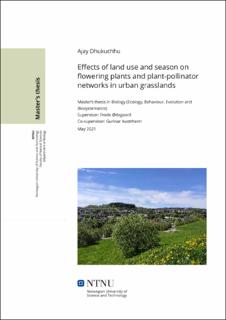| dc.description.abstract | Plant-pollinator ecological relationship is crucial interaction in global biodiversity as it maintains pollination services and balances biotic communities in the ecosystem. Land-use changes in urban grasslands may affect the plant-pollinator interaction by changing the plant-pollinator composition and their relationship. In addition, seasonal changes will also affect the interaction networks by influencing the phenology of flowering plant species and determining the resource availability for pollinators. Pollination services in urban habitats are considered to be threatened, but few studies have examined plants and pollinators regarding the pollination interactions in Norway. This study has examined the effects of land-use changes and season on flowering plant species and plant-pollinator interaction by mapping pollination networks in two land-use types along with seasonal shifts in grasslands in Trondheim municipality. This study focused on the change in flowering plant richness and abundance with their impact on bumblebee richness and interactions network at the species level of bumblebee and different pollinator groups in different seasons. Floral richness, floral abundance, pollinator abundance, and bumblebee richness were found higher in semi-natural grasslands than in successional grasslands. These results show that changes in land use will affect plant and pollinator community composition. Furthermore, network indices like links per species, Shannon diversity, and Specialization Index (H2') were calculated. These network indices showed that with the increasing number of links per species and species diversity, networks were more specialized in semi-natural grasslands than in successional grasslands for both bumblebee species and pollinator group networks as determined by the specialization index. With the change in season, the diversity and links per species varied, and the network specialization of respective grasslands. The results suggest that plant-pollinator networks will change throughout the growing season due to resource availability in existing land-use types, determined by the changes in land use. Therefore, conservation and land-use management practices should be promoted to enhance the pollination services and maintain the plant and pollinator biodiversity in the existing urban grasslands. | |
